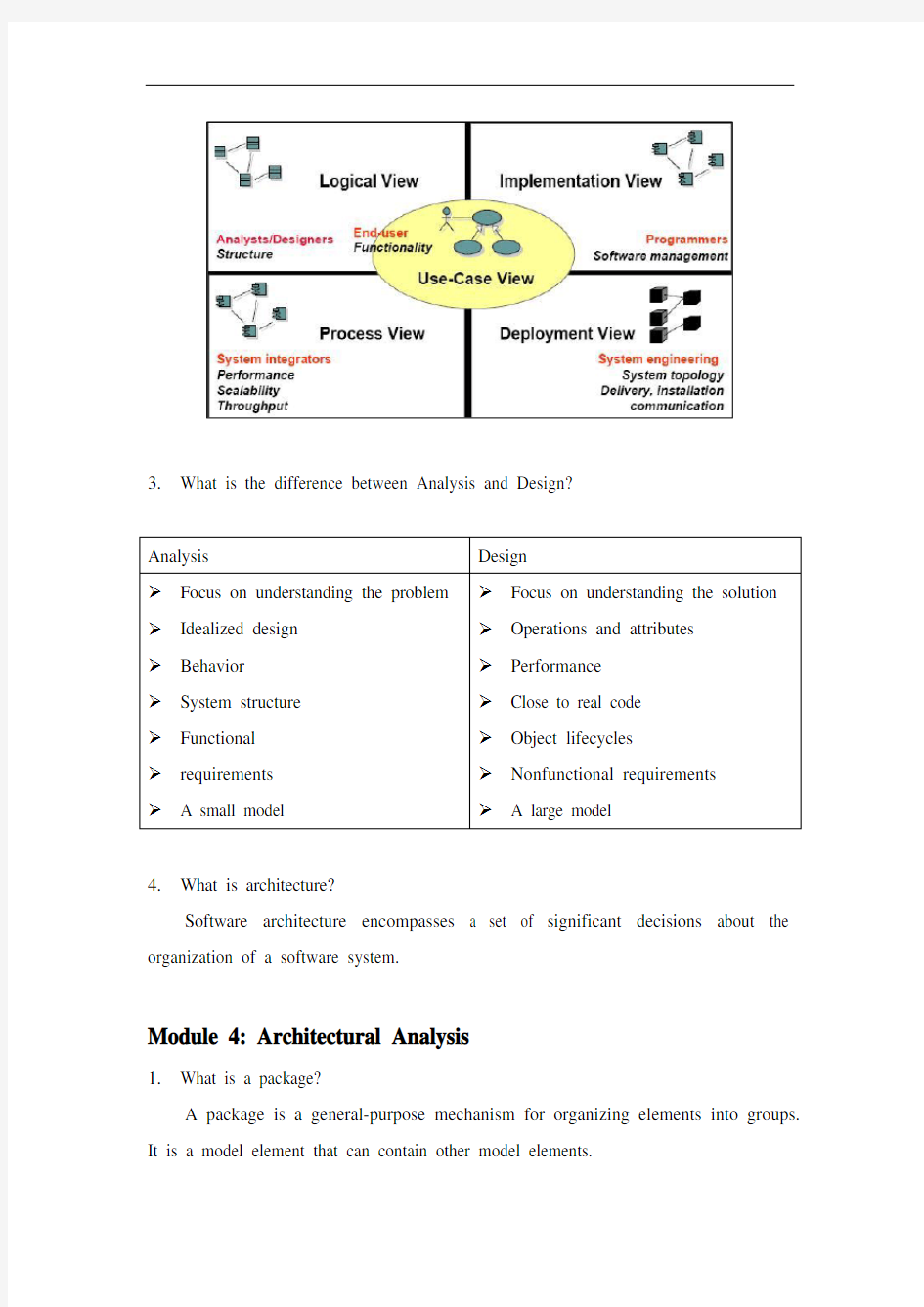

Module 2: Requirements Overview
1.What is a Use-Case Model?
A model that describes a system’s functional requirements in terms of use cases;
A model of the system’s intended functionality(use cases) and its environment (actors).
2.What is an actor?
An actor represents anything that interacts with the system.
3.What is a use case? List examples of use case properties.
A use case is a sequence of actions a system performs that yields an observable result of value to a particular actor.
4.What is the difference between a use case and a scenario?
A scenario is an instance of a use case.
5.What is a Supplementary Specification and what does it include?
Functionality、Usability、Reliability、Performance、Supportability、Design constraints、Supplementary、Specification
Module 3: Analysis and Design Overview
1.What is the purpose of the Analysis and Design Discipline?
The purposes of Analysis and Design are to:
Transform the requirements into a design of the system-to-be.
Evolve a robust architecture for the system.
Adapt the design to match the implementation environment, designing it for performance.
https://www.doczj.com/doc/cd18793613.html, and briefly describe the 4+1 Views of Architecture.
3.What is the difference between Analysis and Design? Analysis Design
?Focus on understanding the problem ?Idealized design
?Behavior
?System structure
?Functional
?requirements
? A small model ?Focus on understanding the solution ?Operations and attributes
?Performance
?Close to real code
?Object lifecycles
?Nonfunctional requirements
? A large model
4.What is architecture?
Software architecture encompasses a set of significant decisions about the organization of a software system.
Module 4: Architectural Analysis
1.What is a package?
A package is a general-purpose mechanism for organizing elements into groups. It is a model element that can contain other model elements.
2.What is a layered architecture? Give examples of typical layers.
Module 5: Use-Case Analysis
1.What is an analysis class? Name and describe the three analysis stereotypes.
Boundary Class、Entity Class、Control Class.
2.What is a Use-Case Realization?
Use-Case Realization provides traceability from Analysis and Design back to Requirements.
3.How many Interaction diagrams should be produced during Use-Case Analysis?
Two.Collaboration Diagrams and Sequence Diagrams
Module 6: Identify Design Elements
1.What is an interface?
Purpose:
To identify the interfaces of the subsystems based on their responsibilities
2.What is a subsystem? How does it differ from a package?
Subsystems :
Completely encapsulate behavior; Represent an independent capability with clear interfaces (potential for reuse); Model multiple implementation variants
3.What is a subsystem used for, and how do you identify them?
Subsystems can be used to partition the system into parts that can be independently
4.What are some layering and partitioning considerations?
Module 7: Describe the Run-time Architecture
1.What is a process? What is a thread?
2.Describe the two strategies for mapping classes and subsystems to processes.
Two Strategies (used simultaneously):
1)Inside-Out
Group elements that closely cooperate and must execute in the same thread of control
Separate elements that do not interact
Repeat until you reach the minimum number of processes that still provide the required distribution and effective resource utilization
2)Outside-In
Define a separate thread of control for each external stimuli
Define a separate server thread of control for each service
Reduce number of threads to what can be supported
3.How do you model the Process View? What modeling elements and diagrams are
used?
Processes can be modeled using:
Active classes (Class Diagrams) and Objects(Interaction Diagrams)
Components (Component Diagrams)
Module 8: Describe Distribution
1.What i s a node? Describe the two different “types” of nodes.
1)Node:
Physical run-time computational resource
Processor node
Executes system software
Device node
Support device
Typically controlled by a processor
2)Connection:
Communication mechanism
Physical medium
Software protocol
2.Describe some of the considerations when mapping processes to nodes.
Process-to-Node Allocation Considerations
1)Distribution patterns
2)Response time and system throughput
3)Minimization of cross-network traffic
4)Node capacity
5)Communication medium bandwidth
6)Availability of hardware and communication links
7)Rerouting requirements
3.How do you model the Deployment View? What modeling elements and
diagrams are used?
Deployment modeling elements contains node and connection. Reference to Question 1.
Module 9: Use-Case Design
1.What is meant by encapsulating subsystem interactions? Why is it a good thing to
do?
1)Interactions can be described at several levels.
Subsystem interactions can be described in their own interaction diagrams.
2)Advantages of Encapsulating Subsystem Interactions:
Use-case realizations:
Are less cluttered
Can be created before the internal designs of subsystems are created (parallel development)
Are more generic and easier to change(Subsystems can be substituted.)
Module 10: Subsystem Design
1.How many interaction diagrams should be produced during Subsystem Design?
One or more interaction diagrams per interface operation
Module 11: Class Design
1.Are statecharts created for every class?
Statechart is a directed graph of states (nodes) connected bytransitions (directed arcs).Statechart for one of the classes that exhibits state-controlled behavior.
2.What are the major components of a statechart? Provide a brief description of
each.
Significant, dynamic attributes;
Existence and non-existence of certain links;
Events
Transitions
Activities and Actions
3.What is the difference between an association and a dependency?
1)Dependency is a relationship between two objects.
2)Associations are structural relationships
3)Dependencies are nonstructural relationships
4)In order for objects to “know each other” they must be visible
5)An instance of an association is a link
?All links become associations unless they have global, local, or parameter visibility
?Relationships are context-dependent 6)Dependencies are transient links with:
? A limited duration
? A context-independent relationship
? A summary relationship